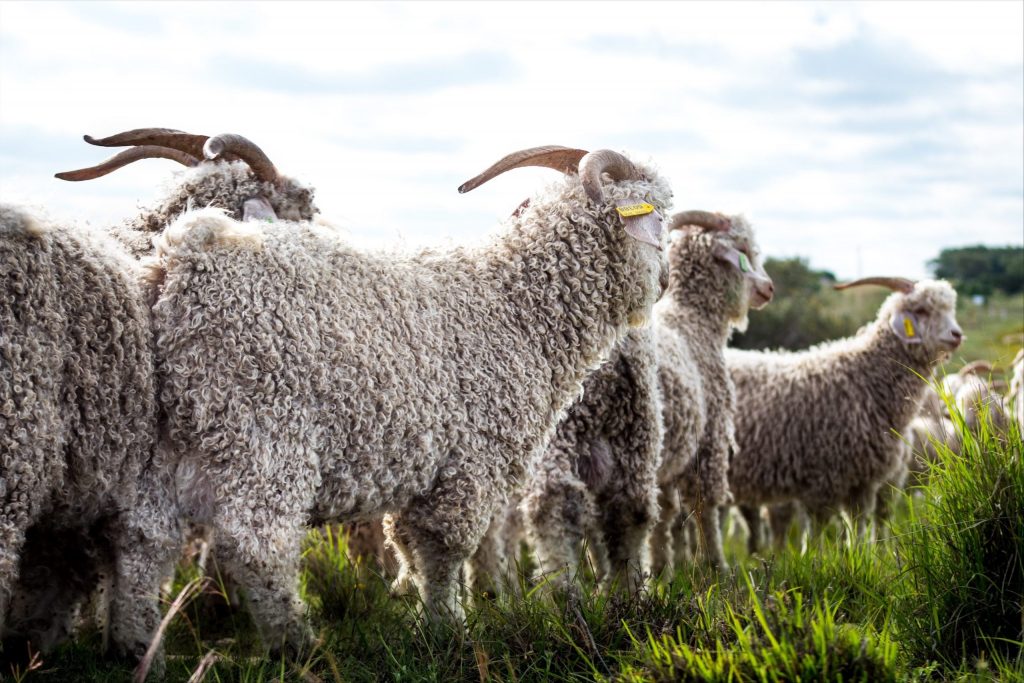Mohair, the Angora Goat, and the Hill Country

Here’s a quick mental exercise for you: if we were to ask you to imagine a typical Texas ranch, what animal would come to mind first? Considering it’s Texas, we’d be willing to wager most people would picture a sprawling pasture populated with Texas Longhorns. After all, the hardy bovine has been a symbol of the Texas cattle drives since the 1860s; it’s the official mascot of the largest university in the state; and it was named the official large mammal of the Lone Star State in 1995. Hook ‘Em Horns and all that.
In this article, we’d like to discuss the role of another ranching animal that has played just as influential a role in the Texas Hill Country as the Longhorn. The humble but productive Angora goat has had its place in those Texas pastures less time than the Longhorns have, but to this day the mohair, meat, and cheese they produce have played important economic and cultural roles in the region, too.
While the breed that became the Texas Longhorn can trace its roots back to the second voyage of Christopher Columbus in the late 15th century, the Angora goat didn’t appear in the United States until almost 400 years later. The breed got its beginnings in the harsh and forbidding Himalayan Mountain region, and were then domesticated as a popular wool-bearing ranch animal in Turkey. James B. Davis of South Carolina bred the Angoras with short-haired domestic goats in 1849, when the Angoras were first introduced to the US. This produced a softer and more durable wool. It was this new hybrid that first came to Texas in the late 1850s, when European immigrant settlement of the Texas Hill Country was really picking up steam.
The Angoras (some people make the distinction of calling them “American Angoras” to separate them from the original Turkish variety) enjoyed up-and-down periods of popularity as the prices of mohair fluctuated, and its role in the fashion world rose and fell. Ranchers loved them, because the hardy animals enjoyed eating brush, which grows abundantly and cheaply in the Hill Country. Not only that, but their feeding patterns allow for the growth of more grass in a sustainable and perpetual cycle. Thanks to William Leslie Black’s zealous support of the Angora and mohair industry toward the end of the 19th century, the number of goats in the area increased from the hundreds to over 15,000. By the turn of the century, the Hill Country was producing almost one-third of the mohair in the United States.
That share exploded to nearly 80 percent of US production by the 1920s, with mohair taken from over two million goats. Those numbers reached an all-time high of 4.5 million animals in 1965, and in the decades since it has reached a fairly stable number of 200,000 goats. In recognition of Texas’ growing role in the mohair industry, the National Association of Mohair Breeders was relocated to Rocksprings from Missouri in 1925 (the modern Mohair Council USA is located in San Angelo, in the northwest Hill Country).
Boutiques, butchers, and other stores all over the Hill Country proudly carry local Angora goat products, from mohair to meat to cheese! If you get a free download of the Texas Hill Country Travel App, you can search over 30 towns in the region; and you’ll find many mohair and Angora retailers under the “Stores” category. The app is available on iPhone and Android, and has many more useful and powerful tools you can use, no matter what you’re looking for in the Hill Country!
Discover the magic of Texas Hill Country with our Facebook Group! Whether you’ve booked a stay with Backroads Reservations, are planning your next getaway, or simply love this scenic region, our community is for you. Connect with fellow fans and celebrate the stunning beauty of the Hill Country!

